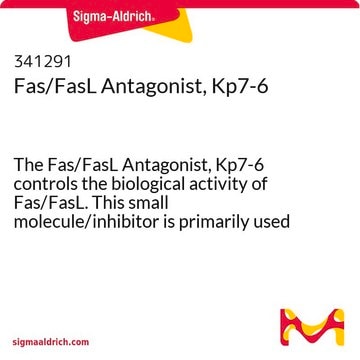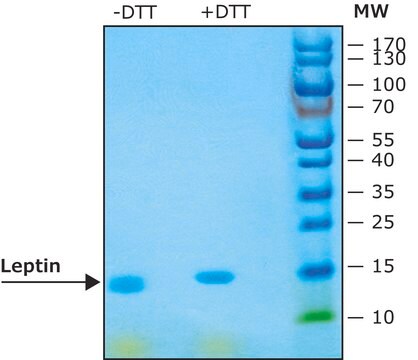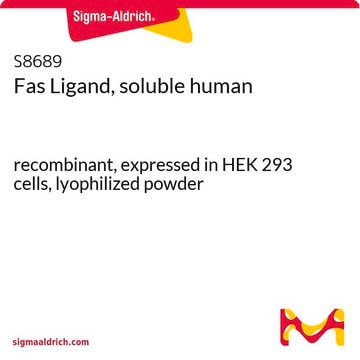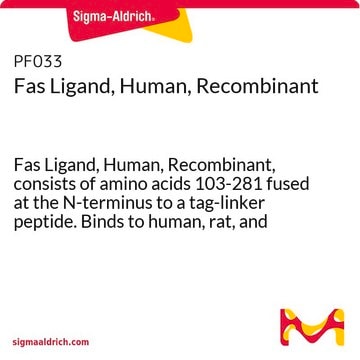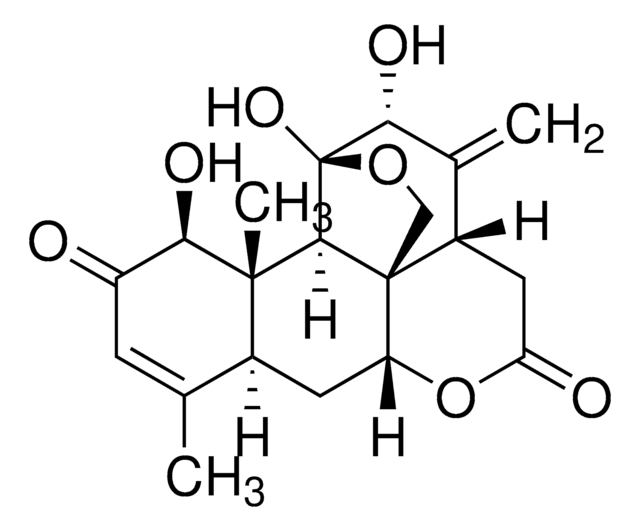F0552
Fas Ligand from mouse
>95% (SDS-PAGE), recombinant, expressed in mouse NSO cells, lyophilized powder
Se connecterpour consulter vos tarifs contractuels et ceux de votre entreprise/organisme
About This Item
Produits recommandés
Produit recombinant
expressed in mouse NSO cells
Niveau de qualité
Pureté
>95% (SDS-PAGE)
Forme
lyophilized powder
Poids mol.
monomer calculated mol wt ~18 kDa
28-32 kDa by SDS-PAGE
Impuretés
endotoxin, tested
Numéro d'accès UniProt
Température de stockage
−20°C
Informations sur le gène
mouse ... Fasl(14103)
Description générale
FASLG (Fas ligand) acts as a ligand for Fas receptor, and is a major protein involved in programmed cell death, apoptosis. Soluble Fas (sFAS) is usually detected in plasma prior to apoptosis.
Application
Fas Ligand (FASLG) from mouse has been used for-
- the induction of apoptosis in PC12 cells and
- the induction of migration in BV-2 murine microglial cells.
Actions biochimiques/physiologiques
FASLG (Fas ligand) and Fas receptor constitute the basic elements in apoptosis. Interaction of FASLG with Fas receptor leads to activation of caspase-8. This caspase in turn leads to activation of effector caspases such as caspase-3, -6 and -7. This cascade results in the hydrolysis of nuclear and cytoplasmic components. Expression of FASLG is induced by nuclear factor-κB (NFκB). NFκB/FASLG pathway facilitates the suppression of p,p′-DDT (dichlorodiphenoxytrichloroethane)-induced cell toxicity by vitamin C and E. In CD4+ T cells, this protein is expressed on stimulus by T-cell receptor (TCR), both during normal and pathological conditions, such as alcohol exposure.
Fas ligand, a protein belonging to the tumor necrosis factor (TNF) family of cytokines, induces apoptosis in cells expressing the cell membrane receptor Fas (CD95/Apo-1).
Autres remarques
Mouse Fas Ligand, N-terminal 6X histidine-tagged, encodes amino acid residues 132-279.
Forme physique
Lyophilized from a 0.2 μm filtered solution in phosphate buffered saline containing 2.5 mg bovine serum albumin.
Remarque sur l'analyse
Measured by its ability to induce apoptosis in Jurkat cells.
Code de la classe de stockage
10 - Combustible liquids
Classe de danger pour l'eau (WGK)
WGK 3
Point d'éclair (°F)
Not applicable
Point d'éclair (°C)
Not applicable
Certificats d'analyse (COA)
Recherchez un Certificats d'analyse (COA) en saisissant le numéro de lot du produit. Les numéros de lot figurent sur l'étiquette du produit après les mots "Lot" ou "Batch".
Déjà en possession de ce produit ?
Retrouvez la documentation relative aux produits que vous avez récemment achetés dans la Bibliothèque de documents.
Xiaoting Jin et al.
PloS one, 9(12), e113257-e113257 (2014-12-03)
Dichlorodiphenoxytrichloroethane (DDT) is a known persistent organic pollutant and liver damage toxicant. However, there has been little emphasis on the mechanism underlying liver damage toxicity of DDT and the relevant effective inhibitors. Hence, the present study was conducted to explore
Aleksander Szymanowski et al.
Atherosclerosis, 233(2), 616-622 (2014-02-19)
Apoptosis of natural killer (NK) cells is increased in patients with coronary artery disease (CAD) and may explain why NK cell levels are altered in these patients. Soluble forms of Fas and Fas ligand (L) are considered as markers of
Ying-mei Lu et al.
Journal of neuroinflammation, 9, 172-172 (2012-07-14)
The cerebral microvascular occlusion elicits microvascular injury which mimics the different degrees of stroke severity observed in patients, but the mechanisms underlying these embolic injuries are far from understood. The Fas ligand (FasL)-Fas system has been implicated in a number
Nicole Suyun Liu et al.
PloS one, 7(8), e43180-e43180 (2012-08-21)
Diva is a member of the Bcl2 family but its function in apoptosis remains largely unclear because of its specific expression found within limited adult tissues. Previous overexpression studies done on various cell lines yielded conflicting conclusions pertaining to its
Smita S Ghare et al.
Journal of immunology (Baltimore, Md. : 1950), 193(1), 412-421 (2014-06-06)
Activation-induced Fas ligand (FasL) mRNA expression in CD4+ T cells is mainly controlled at transcriptional initiation. To elucidate the epigenetic mechanisms regulating physiologic and pathologic FasL transcription, TCR stimulation-responsive promoter histone modifications in normal and alcohol-exposed primary human CD4+ T
Notre équipe de scientifiques dispose d'une expérience dans tous les secteurs de la recherche, notamment en sciences de la vie, science des matériaux, synthèse chimique, chromatographie, analyse et dans de nombreux autres domaines..
Contacter notre Service technique
